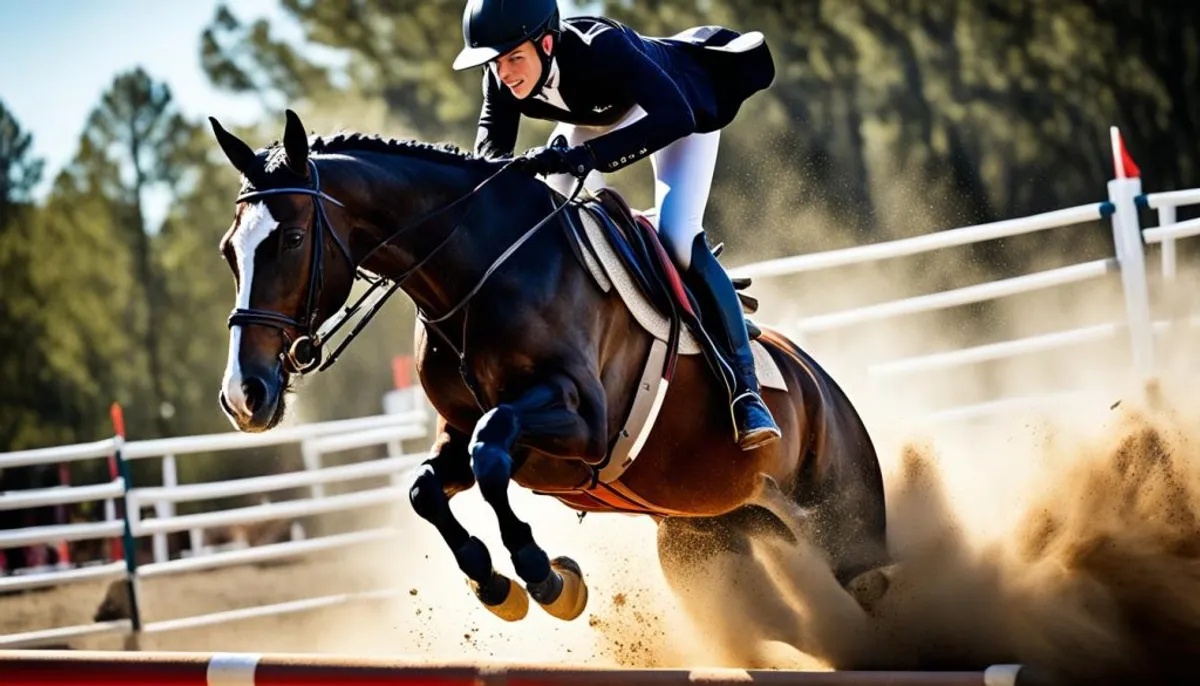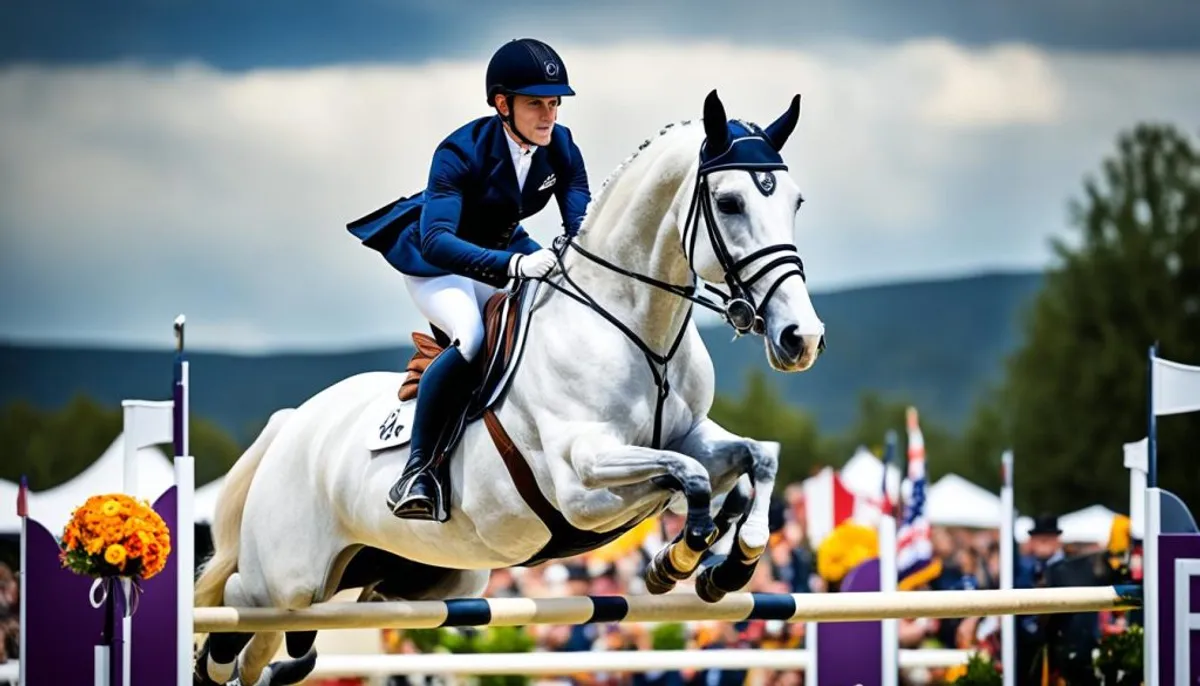The double in equestrianism is a rare and exceptional feat in the equestrian world. It means winning two first places in the same equestrian competition. The events are often different, such as dressage and .
This performance requires an extraordinary level of mastery and partnership. Only a few champions have achieved this feat. Charlotte Dujardin and her horse Valegro are among them, having won the Olympic double in dressage.

Main ideas to remember
- The double in equestrianism is a rare and exceptional feat
- It consists of winning two first places in distinct events
- This requires exceptional mastery and partnership between the rider and the horse
- Only a few equestrian champions have achieved this Olympic double
- Charlotte Dujardin and Valegro are among the legendary pairs that have accomplished this feat
The exceptional synergy between rider and horse
Equestrian sport is unique because it creates a union between the rider and their horse. This rider-horse synergy leads to incredible performances. It has allowed for Olympic records in equestrianism to be broken over the years.
Olympic records illustrating this unique union
The highest record in dressage is 93.857% by Charlotte Dujardin and Valegro in 2016. Other legendary equestrian pairs have also made history. For example, Ulrich Kirchhoff and Jus De Pomme achieved unprecedented doubles.
| Legendary Pair | Event | Year | Performance |
|---|---|---|---|
| Charlotte Dujardin and Valegro | Olympic Dressage | 2016 | 93.857% |
| Ulrich Kirchhoff and Jus De Pomme | Multiple event(s) | Several years | Unprecedented doubles |
An age-limitless sport
Olympic equestrianism has no age limit for athletes. There are child prodigies in equestrianism like Luiza Tavares de Almeida from Brazil. And also equestrian veterans like Arthur von Pongracz from Austria or Andrew Hoy from Australia, who won a medal at 62 years old.
The record holder for Olympic participations
The Canadian Ian Millar participated in the Olympics 10 times, from 1972 to 2012. This shows that equestrianism is a sport without age limits.

Whether for the young or the veterans, equestrianism allows everyone to shine on the international stage. It shows that age is not an obstacle.
When equestrian sport is adorned with anecdotes
Olympic equestrian sport has seen amusing yet impressive incidents. These anecdotes showcase the unpredictability and passion of this sport.
Amusing yet impressive incidents
At London 2012, Simon Delestre, a French rider, jumped with a broken rein. He demonstrated his mastery and responsiveness. At Rio 2016, his horse Hermès Ryan des Hayettes was injured in its stall, preventing him from participating.
Despite these incidents, the horses were able to continue their careers successfully. This shows the resilience of these extraordinary athletes.
These anecdotes highlight the unpredictable yet exciting nature of Olympic equestrianism. The slightest incident can become a sporting achievement.
| Significant Incidents | Riders | Horses |
|---|---|---|
| Broken rein | Simon Delestre | N/A |
| Injury in the stall | Simon Delestre | Hermès Ryan des Hayettes |
A double in equestrianism, the ultimate challenge
Winning the top two places in a competition is a major sporting challenge. Some riders have succeeded in this double in equestrianism. They have proven their excellence in equestrianism.
Noémie Bosc, triumphant young prodigy
The French Noémie Bosc, aged 22, has made history. She won two competitions with her horses in Sandillon. It is a historic double.
Grégory Wathelet, master of Bond Jamesbond de Hay
The Belgian Grégory Wathelet shone with Bond Jamesbond de Hay. He won the World Cup Grand Prix at Equita Lyon. He even defeated the favorite, Julien Epaillard.

These performances highlight the importance of the double in equestrianism. They demonstrate an intense challenge. They require a technical mastery and perfect understanding between rider and horse.
The multiple faces of Olympic equestrianism
The equestrian events at the Olympic Games today include dressage, show jumping, and eventing. However, other disciplines have existed in the past. Olympic polo and Olympic vaulting showcase the diversity of equestrianism on the international stage.
Olympic polo: a vanished tradition
Polo was present at the Olympic Games from 1900 to 1936. This discipline combines agility, strategy, and teamwork. However, Olympic polo has disappeared from the program, making way for other events.
Olympic vaulting: an unknown discipline
Olympic vaulting was part of the program in 1920. It consists of acrobatic exercises on a moving horse. Despite its charm, it did not last in the Olympic program.
These disciplines, even if disappeared, show the richness and diversity of Olympic equestrianism.
Multi-talented athletes, riders with multiple facets
In the world of Olympic equestrianism, some riders shine. They do not limit themselves to their skills on the horse. They also excel in other sports. These multi-talented riders showcase their athletic versatility.
The Swede Lars Daniel Norling is a perfect example. He has won gold medals in both equestrianism and gymnastics. His ability to switch disciplines is incredible.
The French Michel Robert has also demonstrated adaptability. He transitioned from eventing to show jumping. This shows his extraordinary talent.
The Japanese Hiroshi Hoketsu and the French Vladimir Vinchon have chosen a more marked cross-discipline transition. They have successfully combined equestrianism with other sports.
These multi-talented riders inspire and fascinate. Their journey shows that the limits of equestrian sports are meant to be pushed. Their diverse talents showcase the richness of a well-rounded athlete.
Conclusion
The double in equestrianism is a great challenge. It requires a unique partnership between the rider and their mount. Only a few champions achieve it.
This sport fascinates with its diversity. It includes disciplines and athletes of all ages, from young prodigies to veterans. The records and anecdotes make it a captivating sport.
Equestrianism is more than just a sport. It combines tradition, passion, and innovation. With its history and evolution, each edition is unique and memorable.
FAQ
What is the double in equestrianism?
The double in equestrianism means winning the top two places in two different events, such as dressage and show jumping. It shows a very strong bond between the rider and their horse.
What are the most remarkable Olympic records in equestrianism?
Charlotte Dujardin and Valegro broke the dressage record with 93.857%. Ulrich Kirchhoff and Jus De Pomme also made history with unprecedented doubles.
What are the varied profiles of athletes in Olympic equestrianism?
Olympic equestrianism has no age limit for participants. It features young talents and veterans like Arthur von Pongracz and Andrew Hoy. Ian Millar has participated in the Games the most often, 10 times.
What are the most significant incidents in Olympic equestrianism?
There have been incidents like Simon Delestre with a broken rein at London 2012. At Rio 2016, Hermès Ryan des Hayettes was injured, preventing his rider from participating.
Who are the riders who have achieved exceptional doubles?
Noémie Bosc recently won with two horses at the Sandillon Eventing Competition. Grégory Wathelet won the World Cup Grand Prix at Equita Lyon with Bond Jamesbond de Hay.
What equestrian disciplines have been part of the Olympic Games?
The current events include dressage, show jumping, and eventing. Polo and vaulting were included in the past, showcasing the diversity of equestrian sport.
What are examples of versatile Olympic riders?
Riders like Lars Daniel Norling have won in gymnastics and equestrianism. Michel Robert changed disciplines, moving from eventing to show jumping. Hiroshi Hoketsu and Vladimir Vinchon have also succeeded in multiple sports.
RelatedRelated articles



